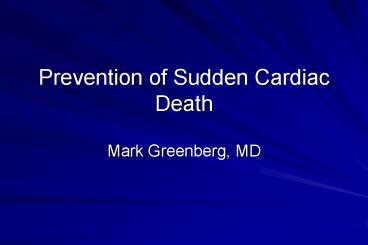Prevention of Sudden Cardiac Death - PowerPoint PPT Presentation
1 / 30
Title:
Prevention of Sudden Cardiac Death
Description:
Surveillance Research, Cancer Facts and Figures 2001. ... Transvenous, single incision. Local anesthesia; conscious sedation. Short hospital stays ... – PowerPoint PPT presentation
Number of Views:1367
Avg rating:3.0/5.0
Title: Prevention of Sudden Cardiac Death
1
Prevention of Sudden Cardiac Death
- Mark Greenberg, MD
2
Magnitude of Sudden Cardiac Arrest in the U.S.
167,366
Stroke3
450,000
Sudden cardiac arrest claims more lives each year
than these other diseases combined
Sudden Cardiac Arrests4
Lung Cancer2
157,400
1 Killer in the U.S.
40,600
Breast Cancer2
42,156
AIDS1
1 U.S. Census Bureau, Statistical Abstract of
the United States 2001. 2 American Cancer
Society, Inc., Surveillance Research, Cancer
Facts and Figures 2001. 3 2002 Heart and Stroke
Statistical Update, American Heart Association. 4
Zheng Z. Circulation. 20011042158-2163.
3
(No Transcript)
4
Treatments to Reduce Sudden Cardiac Death
- Improving Pump Function
- ACE inhibitor
- Beta-blocker
- Prevention of Arrhythmias
- Beta-blocker
- Amiodarone
- Terminating Arrhythmias
- ICDs
- AEDs
- Prevent Ventricular Remodeling and Collagen
Formation - Aldosterone receptor blockade
- Correcting Ischemia
- Revascularization
- Beta-blocker
- Preventing Plaque Rupture
- Statin
- ACE inhibitor
- Aspirin
- Stabilizing Autonomic Balance
- Beta-blocker
- ACE inhibitor
Zipes DP. Circulation. 1998982334-2351. Pitt B.
N Engl J Med. 20033481309-1321.
5
Secondary Prevention of SCD--Conclusions from
Three RCTs
- The ICD is first-line therapy for patients with
hemodynamically-compromising primary ventricular
tachyarrhythmias (relative mortality reduction of
27 compared to medication). - Benefit of ICD mainly with EFlt35, and is
independent of beta blocker use. - Further study is required to assess the
cost-efficacy of the ICD in other patient
subsets (EFgt35, well-tolerated VT, secondary
VT/VF).
6
Evolution of ICD Therapy 1980 to Present
1980
1985
1990
1995
2000 E
7
Implantable Cardioverter Defibrillator
First-line therapy for patients at risk for VT/VF
- Small devices, pectoral implant site
- Transvenous, single incision
- Local anesthesia conscious sedation
- Short hospital stays
- Few acute complications
- Perioperative mortality lt 1
- Programmable therapy options
- Single- or dual-chamber therapy
- Battery longevity up to 9 years
- 80,000 implants/year (2000 E)1
1Morgan Stanley Dean Witter. Investors Guide to
ICDs. 2000.
8
Syncope with structural heart disease is a risk
factor for sudden cardiac death.
9
Reduced left ventricular ejection fraction
(LVEF) remains the single most important risk
factor for overall mortality and sudden cardiac
death.1
1Prior SG, Aliot E, Blonstrom-Lundqvist C, et al.
Task Force on Sudden Cardiac Death of the
European Society of Cardiology. Eur Heart J,
Vol. 22 16 August 2001.
10
MULTICENTER AUTOMATIC DEFIBRILLATOR IMPLANTATION
TRIAL-II (MADIT-II) 1997-2001 A trial
designed to evaluate the effect of prophylactic
ICD therapy on survival in patients with prior MI
and LV dysfunction. Supported by a research
grant from Guidant Corp.
11
MADIT-II Eligibility
- Chronic CAD with prior MI
- EFlt0.30
- No requirement for NSVT or EPS
- No upper age limitation
12
MADIT-II MEDS at Last Follow-Up
- CONV DEFIB
- (n490) (n742)
- percent
- ACE inhibitors 72 68
- Amiodarone 10 13
- Antiarrhythmics 2
3 - Beta-blockers 70 70
- Digitalis 57 57
- No significant differences between CONV and
DEFIB groups.
13
MADIT-II CONCLUSION
- In coronary patients with LVEF lt0.30,
prophylactic ICD therapy is associated with 31
reduction in mortality. - This improved survival is on top of optimal
medical Rx.
14
ICD Cost-Effectiveness Results for High Risk
Post-MI Patients
100,000
Other Therapies
Conclusions
- MUSTT patients are similar to MADIT patients.
- ICD therapy is cost-effective for high risk post
MI patients.
Expensive
80,000
60,000
57,300
Borderline Cost-Effective
LYS
44,300
40,000
28,400
Cost-Effective
22,800
16,900
20,000
Highly Cost-Effective
0
8 yr ICD
Transvenous ICD
Captopril Post MI EF lt .402
Cardiac Transplant CHF Transplant Candidate2
Peritoneal Dialysis3
MADIT Patient1
1 Mushlin A. Circulation. 1998972129-35. 2
Kupersmith J. Progress in Cardiovascular
Diseases. 199537307-46. 3 Kupperman M.
Circulation. 19908191-100.
15
ICD Trials Summary
1 The AVID Investigators. N Engl J Med.
19973371576-1583. 2 Connolly SJ. Circulation.
2000 101 1297-1302. 3 Moss AJ. N Engl J Med.
19963351933-1940.
4 Buxton AE. N Engl J Med. 1999 3411882-90. 5
Moss AJ. N Engl J Med. 2002346877-83.
16
(No Transcript)
17
MADIT II Milestones
2002-2003
NEJM publication
FDA approval
ACC/AHA/NASPE Guidelines updated
BCBS, Aetna, Kaiser recommend coverage
Modified CMS approval
18
(No Transcript)
19
CMS double bind
- You need an ICD, but it may not be reimbursed.
20
SCD-HeFT Hypothesis
- In patients with moderately symptomatic CHF
and LVEF lt35, amiodarone and/or ICD added to
standard medical Rx will be associated with
reduced mortality compared with standard medical
Rx alone.
21
(No Transcript)
22
SCD-HeFT Patient Characteristics
- Patients enrolled 2521
- NYHA Class 70 NYHA II, 30 NYHA III
- Median follow-up 45.5 months
- Median age 60 years
- female 23
- Median EF 25
- Concomitant Rx ACE 72, beta blocker 78
23
(No Transcript)
24
(No Transcript)
25
Mechanism Linking MTWA toVentricular Arrhythmias
Long APD Region
Short APD Region
Long APD Short APD Long APD Short APD
Spatially Discordant Alternans Leads
to Dispersion of Recovery, Wave Front
Fractionation, and Reentry
Action Potential Alternans Leads to T-Wave
Alternans
26
Patient MSModified Bruce Protocol
27
Equivalency Between TWA and EPS
10
EPS
- 10
EventRate
1 year
Time
28
Ultimately, risk stratification will be
important only if it can be coupled with a
therapeutic intervention that reduces the risk of
dying.
Zipes and Wellens. Sudden Cardiac Death.
Circulation. 1998982334-51.
29
High Risk Groups for SCD
Adapted from Myerburg
30
Sudden Cardiac Death Management Strategies
- Salvage and treat (too few are salvaged).
- Predict and prevent (pathophysiology complex,
positive predictive value of risk stratifiers
relatively low).































